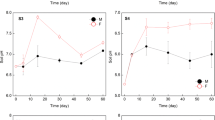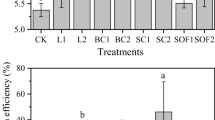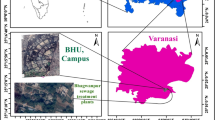Abstract
Sewage contains several trace elements of environmental concern, and cadmium (Cd) is one of the most mobile elements in soil–plant system that can pose drastic effects on plants and human health due to its long persistence and non-biodegradability nature in environment. It is necessary to prevent its entry into food chain for better food quality and human health. Present study was designed to evaluate the effectiveness of different water management practices, viz. W1: flooding throughout the growing season, W2: flooding after 4 days of disappearance of standing water (DAD), W3: flooding till heading and after that flooding of soil after 4 days of DAD, W4: Aerobic condition throughout growing season (flooding after 8 days) for reducing Cd concentration in rice grain grown under varying levels of Cd (0, 20, 40 mg kg−1) spiked soil. Results revealed that grain yield declined with increasing Cd levels but maximum plant height (89.3 cm), straw yield (16.9 g) and grain yield (22.5 g pot−1) was observed where pots were flooded till heading and thereafter flooding. Cadmium concentration increased with increasing concentration of Cd in soil. Further, it is added that the lowest Cd concentration in shoot, grain and husk and translocation factor were observed under W3 when the soil was spiked with 40 mg kg−1. In crux, continuous flooding till heading and thereafter flooding after 4 DAD can significantly decrease the grain Cd concentration without compromise on yield.





Similar content being viewed by others
References
AOAC (1990) Official and tentative methods of analysis. Association of official agricultural chemists. AOAC Inc, Arlington
Arao T, Kawasaki A, Baba K, Mori S, Matsumoto S (2009) Effects of water management on cadmium and arsenic accumulation and dimethylarsinic acid concentrations in Japanese rice. Environ Sci Technol 43:9361–9367
Baker AJM, Brooks RR (1989) Terrestrial higher plants which hyper accumulate metallic elements-a review of their distribution, ecology and phytochemistry. Biorecovery 1:81–126
Cattani I, Romani M, Boccelli R (2008) Effect of cultivation practices on cadmium concentration in rice grain. Agron Sustainable Dev 28:265–271
Chen C-W, Kao C-M, Chen C-F, Dong C-D (2007) Distribution and accumulation of heavy metals in the sediments of Kaohsiung Harbor, Taiwan. Chemosphere 66:1431–1440
Chopala G, Saifullah, Bolan N, Bibi S, Iqbal M, Rengel Z, Kunhikrishman A, Shwath N, OK YS (2014) Cellular mechanism in higher plants governing tolerance to cadmium toxicity. Crit Rev Plant Sci 33:374–391
Chu G, Chen T, Chen S, Xu C, Wang D, Zhang X (2018) The effect of alternate wetting and severe drying irrigation on grain yield and water use efficiency of Indica-japonica hybrid rice (Oryza sativa L.). Food Energy Secur 7:e00133
Díaz-Flores PE, Arcibar-Orozco JA, Perez-Aguilar NV, Rangel-Mendez JR, Medina VO, Alcalá-Jáuegui JA (2017) Adsorption of organic compounds onto multiwall and nitrogen-doped carbon nanotubes: insights into the adsorption mechanisms. Water, Air Soil Pollut 228(4):133
Dixit P, Mukherjee PK, Ramachandran V, Eapen S (2011) Glutathione transferase from Trichodermavirens enhances cadmium tolerance without enhancing its accumulation in transgenic Nicotianatabacum. PLoS ONE 6:e16360
Ekmekci Z, Yilmaz MD, Akkaya EU (2008) A monostyryl-boradiazaindacene (BODIPY) derivative as colorimetric and fluorescent probe for cyanide ions. Org Lett 10(3):461–464
Ensink JH, Mahmood T, Van Der Hoek W, Raschid-Sally L, Amerasinghe F (2004) A nationwide assessment of wastewater use in Pakistan: an obscure activity or a vitally important one? Water Policy 6:197–206
Ethan S (2015) Effect of flooding on chemistry of paddy soils: a review. Int J Innovative Sci Eng Technol 2(4):414–420
Hayes M (2012) Minors latest-cadmium production up in 2011, oversupply looms. U. S Geological Survey, Reston
Honma T, Ohba H, Kaneko-Kadokura A, Makino T, Nakamura K, Katou H (2016) Optimal soil Eh, pH, and water management for simultaneously minimizing arsenic and cadmium concentrations in rice grains. Environ Sci Technol 50:4178–4185
Hou D, Wang K, Liu T, Wang H, Lin Z, Qian J, Lu L, Tian S (2017) Unique rhizosphere micro-characteristics facilitate phytoextraction of multiple metals in soil by the hyper accumulating plant sedum alfredii. Environ Sci Technol 51(10):5675–5684
Hu P, Ouyang Y, Wu L, Shen L, Luo Y, Christie P (2015) Effects of water management on arsenic and cadmium speciation and accumulation in an upland rice cultivar. J Environ Sci 27:225–231
Kibria M, Osman K, Ahmed MJ (2006) Cadmium and lead uptake by rice (Oryza sativa L.) grown in three different textured soils. Soil Environ 25:70–77
Murtaza G, Javed W, Hussain A, Wahid A, Murtaza B, Owens G (2015) Metal uptake via phosphate fertilizer and city sewage in cereal and legume crops in Pakistan. Environ Sci Pollut Res 22:9136–9147
Puschenreiter M, Horak O, Friesl W, Hartl W (2005) Low-cost agricultural measures to reduce heavy metal transfer into the food chain–a review. Plant Soil Environ 51:1–11
Ramadan MA, Al-Ashkar EA (2007) The effect of different fertilizers on the heavy metals in soil and tomato plant. Aus J Basic Appl Sci 1:300–306
Riaz U, Murtaza G, Saifullah Farooq M (2018) Influence of different sewage sludges and composts on growth, yield, and trace elements accumulation in rice and wheat. Land Degrad Dev 29(1):1343–1352
Saifullah Sarwar N, Bibi S, Ahmad M, Ok YS (2014) Effectiveness of zinc application to minimize cadmium toxicity and accumulation in wheat (Triticum aestivum L.). Environ Earth Sci 71:1663–1672
Sarwar N, Malhi SS, Zia MH, Naeem A, Bibi S, Farid G (2010) Role of mineral nutrition in minimizing cadmium accumulation by plants. J Sci Food Agric 90:925–937
Shukla U, Singh J, Joshi P, Kakkar P (2003) Effect of bioaccumulation of cadmium on biomass productivity, essential trace elements, chlorophyll biosynthesis, and macromolecules of wheat seedlings. Biol Trace Element Res 92:257–273
Singh P, Tewari R (2003) Cadmium toxicity induced changes in plant water relations and oxidative metabolism of Brassica juncea L. plants. J Environ Biol 24:107–112
Soltanpour PN, Schwab AP (1977) A new soil test for simultaneous extraction of macro-and micro nutrients in alkaline soils. Commun Soil Sci Plant Anal 8(3):195–207
Sun L, Zheng M, Liu H, Peng S, Huang J, Cui K, Nie L (2014) Water management practices affect arsenic and cadmium accumulation in rice grains. Sci World J. https://doi.org/10.1155/2014/596438
Yang J, Huang D, Duan H, Tan G, Zhang J (2009) Alternate wetting and moderate soil drying increases grain yield and reduces cadmium accumulation in rice grains. J Sci Food Agric 89(10):1728–1736
Author information
Authors and Affiliations
Corresponding author
Rights and permissions
About this article
Cite this article
Naveed, M., Saifullah, Riaz, U. et al. Strategic use of water: a step toward cadmium-free basmati rice (Oryza sativa L.). Paddy Water Environ 16, 867–873 (2018). https://doi.org/10.1007/s10333-018-0675-6
Received:
Revised:
Accepted:
Published:
Issue Date:
DOI: https://doi.org/10.1007/s10333-018-0675-6




